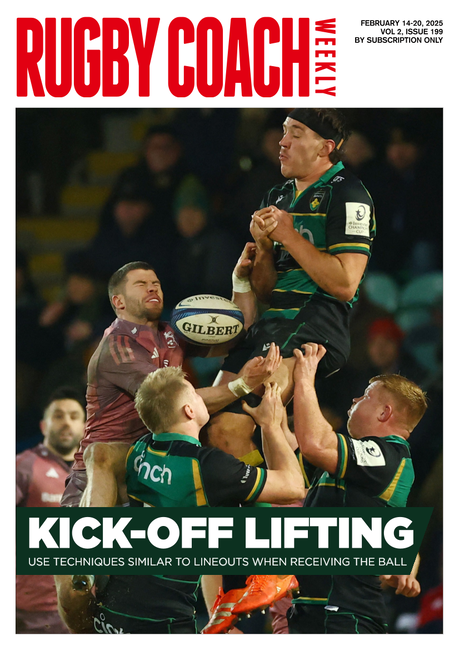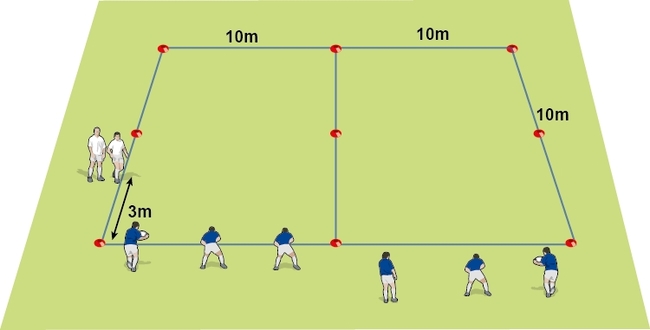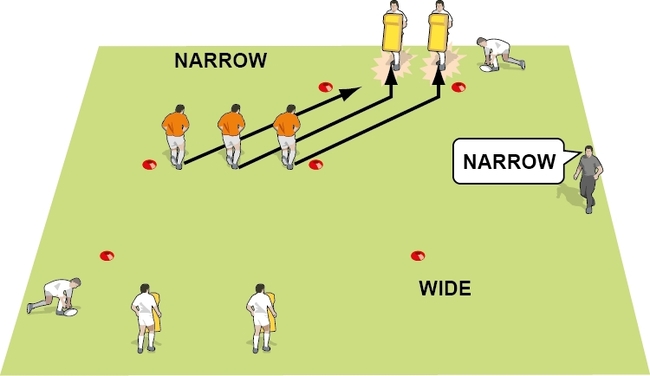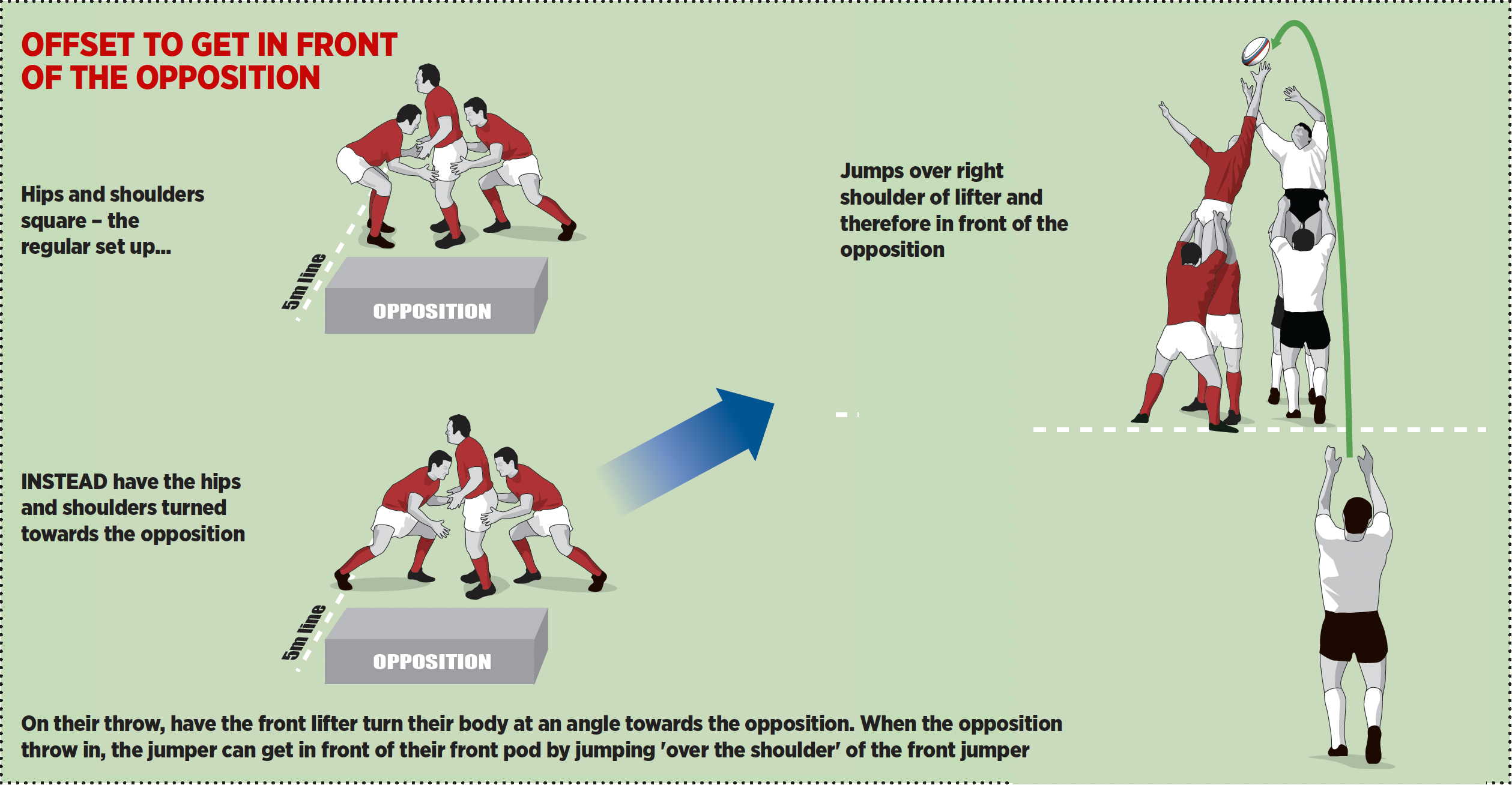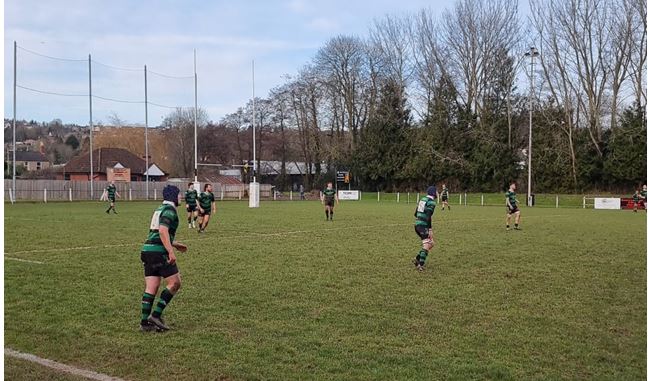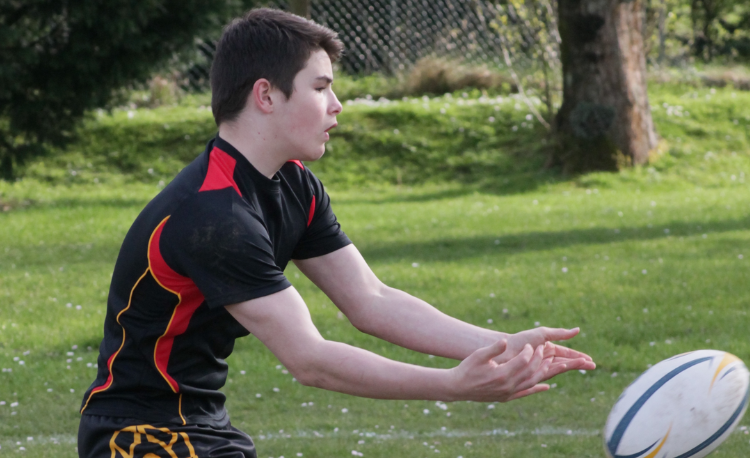Introducing the blitz
Defenceby Rowland Phillips
You might be coaching your team the blitz for the first time or reintroducing it. Here's how I have introduced my system of the blitz to teams.

More and more teams are using the blitz, but the system is not one that you can just throw at the players and expect them to use. You need the players to buy in to the concept.
There are two stages to this process.
It is important that in training we start the process progressively. I mainly concentrate on phase play blitz. Simply, in a game you defend more rucks than set pieces, so this should be the fi rst defensive focus.
So, again with use of video analysis and clips from previous games, I will make players look for effectiveness around rucks. I do not want players becoming 'ruck inspectors', simply looking into the ruck. They need to be dynamic, ready to perform a positive defensive role. Ruck defence is the foundation of any defensive system or structure.
The players need to draw out how the blitz can be put in place. There is a cause and effect in the game. The effectiveness of the tackle allows time to get into place to blitz. As a team, we will then be working on making offensive tackles that slow the opposition down.
Finally, as with any new concept, 'blitz buy in time' must be punchy . Boring sessions lose the players' belief in the system.
Most of the defensive work in pre-season training concentrates on the key factors in tackling. I progress these over the weeks so that the previous week's work can be revised in a short space of time at every new session. I keep this fresh, by adjusting the exercise a little each time.
As sessions progress, I will add a twist into revision exercises. For instance in a 1 v 1 tackle technique session, the tackler might have to shadow the movements of the ball carrier before coming forward to tackle on a cue.
Over time, each exercise can become part of the warm up for the defensive session. I want the session to be action packed, for about an hour at the maximum.
The exercises build towards a structure for our defence. But we always return to basic tackle techniques and 1 v 1 and 2 v 2s.
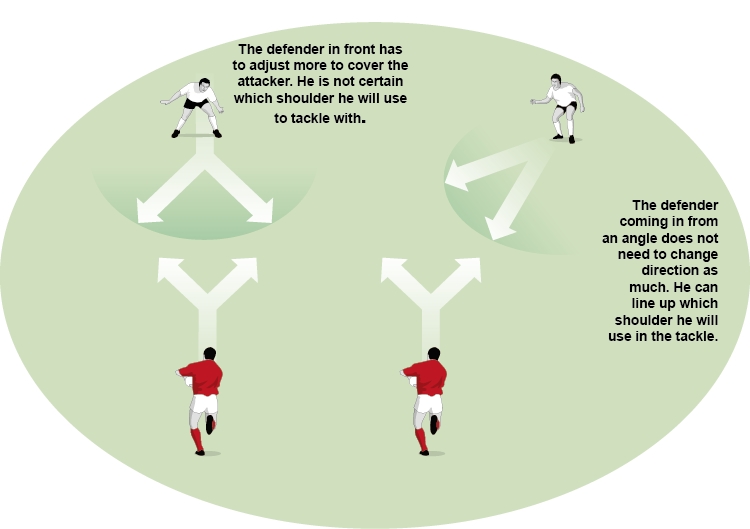
The defender is better off coming from out to in rather than from in front. He will not have to change his angle of attack as much.
A player needs to keep himself aware and ready to adjust his position to deal with the threats. I like to keep my players upright for as long as possible, before dipping down just before the tackle and then driving up. They should stay 'high' and then suddenly go 'low-high'.
Our ruck structure, whether we are blitzing or not, is built around two defenders around the each side of the ruck.
The closest two players are the 'A' defenders. They are in place first. Then the two 'B' defenders are in position next to the 'A' defenders.

We will practise putting these in position in game-related situations. Ideally you fill the far side position first, with the first 'A' defender taking this position. The next 'A' defender gets into position and then the next 'B' defender moves to the far side. And then the players fill in from there. If we have players in place then we can call in a blitz.
In the diagram above you will see how we have built a basic structure for a blitz defence. I will want to test this. I use a simple 4 v 7 game, where four attackers play one phase from a ruck, overloading the advantage to the defence.
There is a metre of space up for grabs just before the contact. The ball carrier often slows a little before contact to step or pass. It is essential that the defender does not do this as well, but takes up that space.
I want a wave of defence that does not stop at the beach. It needs to carry on through the attack. The players on the inside in defence need to continue through and close off the attack coming back.
Putting four attackers against seven defenders allows you to set up a blitz defence exercise that covers the inside and outside runners around the first receiver.
The two closest defenders to the ruck on either side (A and B) go forward to protect the edges of the ruck. The next defender (C) stands opposite the first receiver and the fourth defender, 'the hinge' attacks in on the fi rst receiver.
The rest of the defenders close the door about the hinge. The reason for such an overload is that we need to start with the most secure form of defence. You can take players away when they are more confident.
With the 4 v 7 game, we work at 50% intensity and 100% concentration. Defence needs the same concentration as forwards have at the set piece, but instead it needs to be across the whole team.

BLITZ BUY IN
More and more teams are using the blitz, but the system is not one that you can just throw at the players and expect them to use. You need the players to buy in to the concept.
There are two stages to this process.
- They need to understand what it is. It is not just a race forward for the defence. It has certain rules to when it works and how it works.
- The players will buy into a system where they see there are positive outcomes.
It is important that in training we start the process progressively. I mainly concentrate on phase play blitz. Simply, in a game you defend more rucks than set pieces, so this should be the fi rst defensive focus.
So, again with use of video analysis and clips from previous games, I will make players look for effectiveness around rucks. I do not want players becoming 'ruck inspectors', simply looking into the ruck. They need to be dynamic, ready to perform a positive defensive role. Ruck defence is the foundation of any defensive system or structure.
The players need to draw out how the blitz can be put in place. There is a cause and effect in the game. The effectiveness of the tackle allows time to get into place to blitz. As a team, we will then be working on making offensive tackles that slow the opposition down.
Finally, as with any new concept, 'blitz buy in time' must be punchy . Boring sessions lose the players' belief in the system.
BUILD A STRUCTURE
Most of the defensive work in pre-season training concentrates on the key factors in tackling. I progress these over the weeks so that the previous week's work can be revised in a short space of time at every new session. I keep this fresh, by adjusting the exercise a little each time.
As sessions progress, I will add a twist into revision exercises. For instance in a 1 v 1 tackle technique session, the tackler might have to shadow the movements of the ball carrier before coming forward to tackle on a cue.
Over time, each exercise can become part of the warm up for the defensive session. I want the session to be action packed, for about an hour at the maximum.
The exercises build towards a structure for our defence. But we always return to basic tackle techniques and 1 v 1 and 2 v 2s.
LINE UP AT AN ANGLE TO THE ATTACKER

The defender is better off coming from out to in rather than from in front. He will not have to change his angle of attack as much.
HIGH...LOW, HIGH
A player needs to keep himself aware and ready to adjust his position to deal with the threats. I like to keep my players upright for as long as possible, before dipping down just before the tackle and then driving up. They should stay 'high' and then suddenly go 'low-high'.
TESTING THE STRUCTURE
Our ruck structure, whether we are blitzing or not, is built around two defenders around the each side of the ruck.
The closest two players are the 'A' defenders. They are in place first. Then the two 'B' defenders are in position next to the 'A' defenders.

We will practise putting these in position in game-related situations. Ideally you fill the far side position first, with the first 'A' defender taking this position. The next 'A' defender gets into position and then the next 'B' defender moves to the far side. And then the players fill in from there. If we have players in place then we can call in a blitz.
In the diagram above you will see how we have built a basic structure for a blitz defence. I will want to test this. I use a simple 4 v 7 game, where four attackers play one phase from a ruck, overloading the advantage to the defence.
GRAB THE DEFENSIVE SPACE
There is a metre of space up for grabs just before the contact. The ball carrier often slows a little before contact to step or pass. It is essential that the defender does not do this as well, but takes up that space.
A WAVE OF DEFENCE THAT DOES NOT STOP
I want a wave of defence that does not stop at the beach. It needs to carry on through the attack. The players on the inside in defence need to continue through and close off the attack coming back.
SETTING UP THE 4 V 7 GAME SITUATION
Putting four attackers against seven defenders allows you to set up a blitz defence exercise that covers the inside and outside runners around the first receiver.
The two closest defenders to the ruck on either side (A and B) go forward to protect the edges of the ruck. The next defender (C) stands opposite the first receiver and the fourth defender, 'the hinge' attacks in on the fi rst receiver.
The rest of the defenders close the door about the hinge. The reason for such an overload is that we need to start with the most secure form of defence. You can take players away when they are more confident.
With the 4 v 7 game, we work at 50% intensity and 100% concentration. Defence needs the same concentration as forwards have at the set piece, but instead it needs to be across the whole team.
Newsletter Sign Up
Coaches Testimonials

Gerald Kearney, Downtown Las Vegas Soccer Club

Paul Butler, Florida, USA

Rick Shields, Springboro, USA

Tony Green, Pierrefonds Titans, Quebec, Canada
Subscribe Today
Be a more effective, more successful rugby coach
In a recent survey 89% of subscribers said Rugby Coach Weekly makes them more confident, 91% said Rugby Coach Weekly makes them a more effective coach and 93% said Rugby Coach Weekly makes them more inspired.
Get Weekly Inspiration
All the latest techniques and approaches
Rugby Coach Weekly offers proven and easy to use rugby drills, coaching sessions, practice plans, small-sided games, warm-ups, training tips and advice.
We've been at the cutting edge of rugby coaching since we launched in 2005, creating resources for the grassroots youth coach, following best practice from around the world and insights from the professional game.

